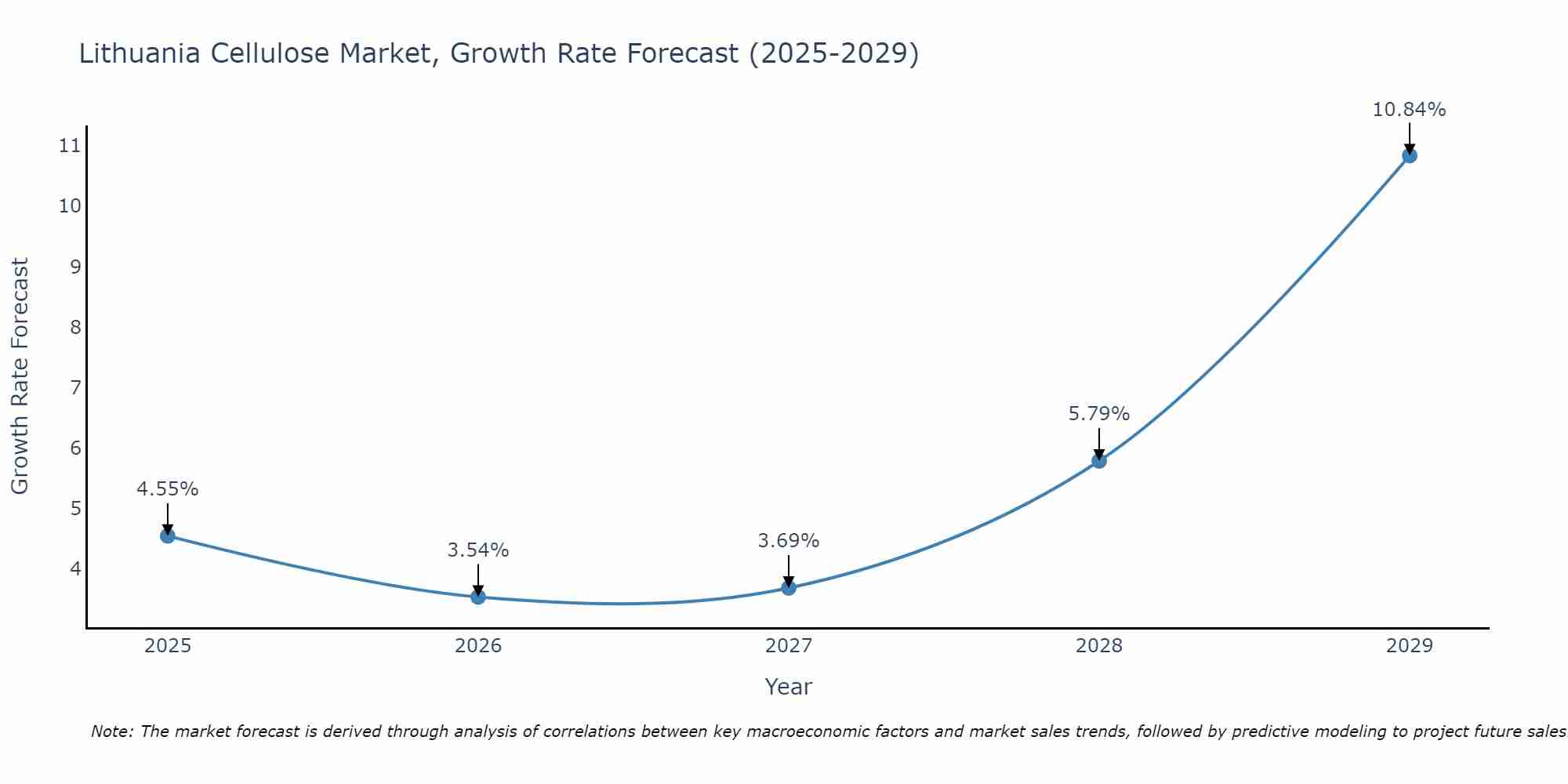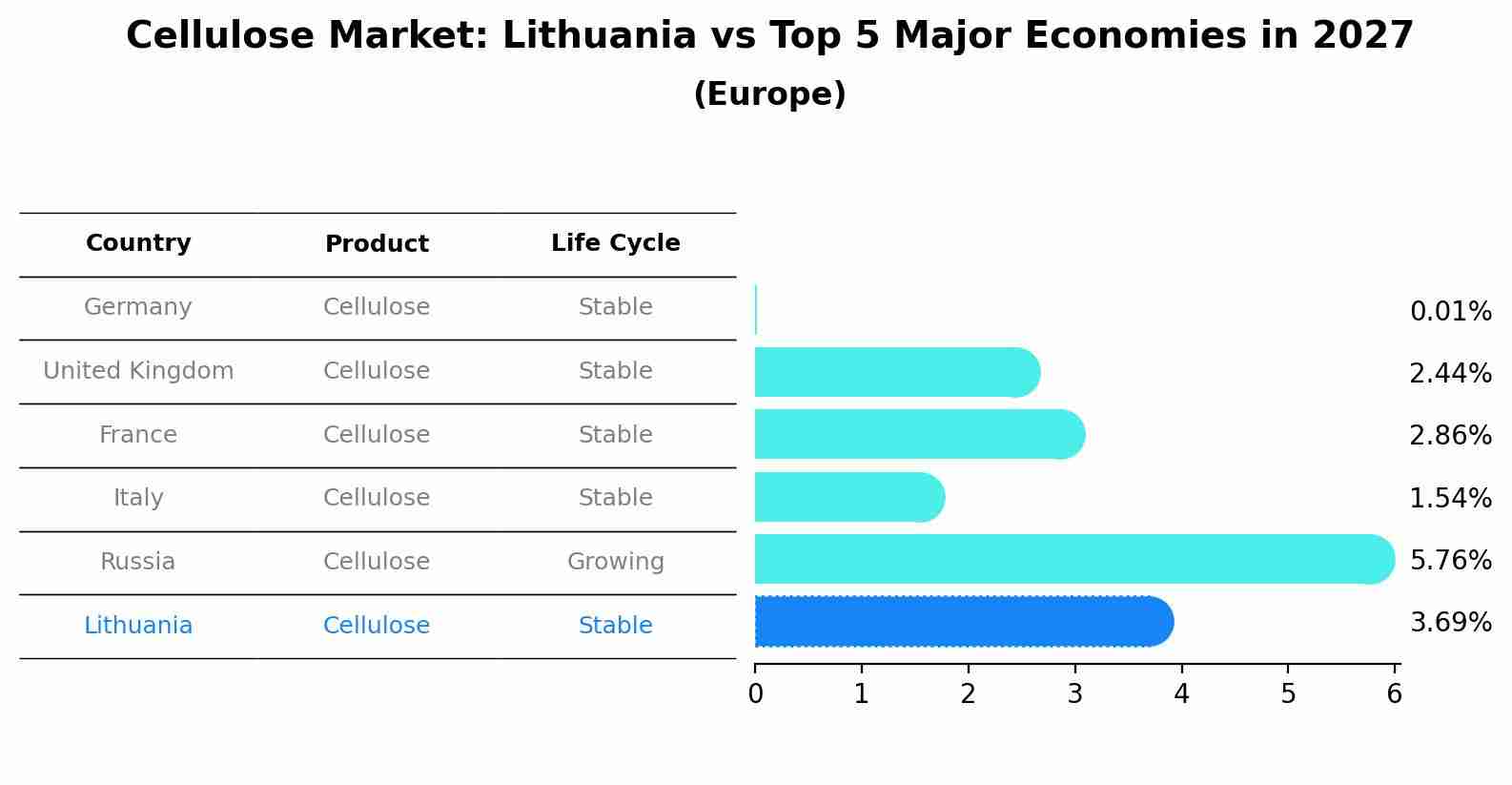Lithuania Cellulose Market (2025-2031) | Size, Growth, Outlook, Analysis, Value, Revenue, Companies, Forecast, Segmentation, Share, Trends & Industry
| Product Code: ETC4661975 | Publication Date: Nov 2023 | Updated Date: Sep 2025 | Product Type: Market Research Report | |
| Publisher: 6Wresearch | No. of Pages: 60 | No. of Figures: 30 | No. of Tables: 5 | |
Lithuania Cellulose Market Size Growth Rate
The Lithuania Cellulose Market is projected to witness mixed growth rate patterns during 2025 to 2029. The growth rate starts at 4.55% in 2025 and reaches 10.84% by 2029.

Cellulose Market: Lithuania vs Top 5 Major Economies in 2027 (Europe)
The Cellulose market in Lithuania is projected to grow at a stable growth rate of 3.69% by 2027, within the Europe region led by Germany, along with other countries like United Kingdom, France, Italy and Russia, collectively shaping a dynamic and evolving market environment driven by innovation and increasing adoption of emerging technologies.

Key Highlights of the Report:
- Lithuania Cellulose Market Outlook
- Market Size of Lithuania Cellulose Market, 2024
- Forecast of Lithuania Cellulose Market, 2031
- Historical Data and Forecast of Lithuania Cellulose Revenues & Volume for the Period 2021-2031
- Lithuania Cellulose Market Trend Evolution
- Lithuania Cellulose Market Drivers and Challenges
- Lithuania Cellulose Price Trends
- Lithuania Cellulose Porter`s Five Forces
- Lithuania Cellulose Industry Life Cycle
- Historical Data and Forecast of Lithuania Cellulose Market Revenues & Volume By Fiber Type for the Period 2021-2031
- Historical Data and Forecast of Lithuania Cellulose Market Revenues & Volume By Natural Cellulose Fibers for the Period 2021-2031
- Historical Data and Forecast of Lithuania Cellulose Market Revenues & Volume By Man-made Cellulose Fibers for the Period 2021-2031
- Historical Data and Forecast of Lithuania Cellulose Market Revenues & Volume By Applications for the Period 2021-2031
- Historical Data and Forecast of Lithuania Cellulose Market Revenues & Volume By Apparel for the Period 2021-2031
- Historical Data and Forecast of Lithuania Cellulose Market Revenues & Volume By Home Textile for the Period 2021-2031
- Historical Data and Forecast of Lithuania Cellulose Market Revenues & Volume By Industrial for the Period 2021-2031
- Historical Data and Forecast of Lithuania Cellulose Market Revenues & Volume By Others for the Period 2021-2031
- Lithuania Cellulose Import Export Trade Statistics
- Market Opportunity Assessment By Fiber Type
- Market Opportunity Assessment By Applications
- Lithuania Cellulose Top Companies Market Share
- Lithuania Cellulose Competitive Benchmarking By Technical and Operational Parameters
- Lithuania Cellulose Company Profiles
- Lithuania Cellulose Key Strategic Recommendations
Frequently Asked Questions About the Market Study (FAQs):
1 Executive Summary |
2 Introduction |
2.1 Key Highlights of the Report |
2.2 Report Description |
2.3 Market Scope & Segmentation |
2.4 Research Methodology |
2.5 Assumptions |
3 Lithuania Cellulose Market Overview |
3.1 Lithuania Country Macro Economic Indicators |
3.2 Lithuania Cellulose Market Revenues & Volume, 2021 & 2031F |
3.3 Lithuania Cellulose Market - Industry Life Cycle |
3.4 Lithuania Cellulose Market - Porter's Five Forces |
3.5 Lithuania Cellulose Market Revenues & Volume Share, By Fiber Type, 2021 & 2031F |
3.6 Lithuania Cellulose Market Revenues & Volume Share, By Applications, 2021 & 2031F |
4 Lithuania Cellulose Market Dynamics |
4.1 Impact Analysis |
4.2 Market Drivers |
4.2.1 Increasing demand for sustainable and eco-friendly products |
4.2.2 Growing awareness regarding the importance of recycling and environmental conservation |
4.2.3 Technological advancements in cellulose extraction and processing |
4.3 Market Restraints |
4.3.1 Fluctuating prices of raw materials |
4.3.2 Stringent regulations and policies related to environmental protection and waste management |
4.3.3 Competition from alternative materials in the market |
5 Lithuania Cellulose Market Trends |
6 Lithuania Cellulose Market Segmentations |
6.1 Lithuania Cellulose Market, By Fiber Type |
6.1.1 Overview and Analysis |
6.1.2 Lithuania Cellulose Market Revenues & Volume, By Natural Cellulose Fibers, 2021-2031F |
6.1.3 Lithuania Cellulose Market Revenues & Volume, By Man-made Cellulose Fibers, 2021-2031F |
6.2 Lithuania Cellulose Market, By Applications |
6.2.1 Overview and Analysis |
6.2.2 Lithuania Cellulose Market Revenues & Volume, By Apparel, 2021-2031F |
6.2.3 Lithuania Cellulose Market Revenues & Volume, By Home Textile, 2021-2031F |
6.2.4 Lithuania Cellulose Market Revenues & Volume, By Industrial, 2021-2031F |
6.2.5 Lithuania Cellulose Market Revenues & Volume, By Others, 2021-2031F |
7 Lithuania Cellulose Market Import-Export Trade Statistics |
7.1 Lithuania Cellulose Market Export to Major Countries |
7.2 Lithuania Cellulose Market Imports from Major Countries |
8 Lithuania Cellulose Market Key Performance Indicators |
8.1 Percentage of cellulose waste recycled annually |
8.2 Adoption rate of eco-friendly packaging solutions using cellulose |
8.3 Research and development investment in new cellulose extraction technologies |
8.4 Carbon footprint reduction achieved through the use of cellulose-based products |
8.5 Number of partnerships and collaborations for promoting sustainable cellulose products |
9 Lithuania Cellulose Market - Opportunity Assessment |
9.1 Lithuania Cellulose Market Opportunity Assessment, By Fiber Type, 2021 & 2031F |
9.2 Lithuania Cellulose Market Opportunity Assessment, By Applications, 2021 & 2031F |
10 Lithuania Cellulose Market - Competitive Landscape |
10.1 Lithuania Cellulose Market Revenue Share, By Companies, 2024 |
10.2 Lithuania Cellulose Market Competitive Benchmarking, By Operating and Technical Parameters |
11 Company Profiles |
12 Recommendations | 13 Disclaimer |
- Single User License$ 1,995
- Department License$ 2,400
- Site License$ 3,120
- Global License$ 3,795
Search
Related Reports
- Vietnam System Integrator Market (2025-2031) | Size, Companies, Analysis, Industry, Value, Forecast, Growth, Trends, Revenue & Share
- ASEAN and Thailand Brain Health Supplements Market (2025-2031) | Strategy, Consumer Insights, Analysis, Investment Trends, Opportunities, Growth, Size, Share, Industry, Revenue, Segments, Value, Segmentation, Supply, Forecast, Restraints, Outlook, Competition, Drivers, Trends, Demand, Pricing Analysis, Competitive, Strategic Insights, Companies, Challenges
- ASEAN Bearings Market (2025-2031) | Strategy, Consumer Insights, Analysis, Investment Trends, Opportunities, Growth, Size, Share, Industry, Revenue, Segments, Value, Segmentation, Supply, Forecast, Restraints, Outlook, Competition, Drivers, Trends, Demand, Pricing Analysis, Competitive, Strategic Insights, Companies, Challenges
- Europe Flooring Market (2025-2031) | Outlook, Share, Industry, Trends, Forecast, Companies, Revenue, Size, Analysis, Growth & Value
- Saudi Arabia Manlift Market (2025-2031) | Outlook, Size, Growth, Trends, Companies, Industry, Revenue, Value, Share, Forecast & Analysis
- Uganda Excavator, Crane, and Wheel Loaders Market (2025-2031) | Strategy, Consumer Insights, Analysis, Investment Trends, Opportunities, Growth, Size, Share, Industry, Revenue, Segments, Value, Segmentation, Supply, Forecast, Restraints, Outlook, Competition, Drivers, Trends, Demand, Pricing Analysis, Competitive, Strategic Insights, Companies, Challenges
- Rwanda Excavator, Crane, and Wheel Loaders Market (2025-2031) | Strategy, Consumer Insights, Analysis, Investment Trends, Opportunities, Growth, Size, Share, Industry, Revenue, Segments, Value, Segmentation, Supply, Forecast, Restraints, Outlook, Competition, Drivers, Trends, Demand, Pricing Analysis, Competitive, Strategic Insights, Companies, Challenges
- Kenya Excavator, Crane, and Wheel Loaders Market (2025-2031) | Strategy, Consumer Insights, Analysis, Investment Trends, Opportunities, Growth, Size, Share, Industry, Revenue, Segments, Value, Segmentation, Supply, Forecast, Restraints, Outlook, Competition, Drivers, Trends, Demand, Pricing Analysis, Competitive, Strategic Insights, Companies, Challenges
- Angola Excavator, Crane, and Wheel Loaders Market (2025-2031) | Strategy, Consumer Insights, Analysis, Investment Trends, Opportunities, Growth, Size, Share, Industry, Revenue, Segments, Value, Segmentation, Supply, Forecast, Restraints, Outlook, Competition, Drivers, Trends, Demand, Pricing Analysis, Competitive, Strategic Insights, Companies, Challenges
- Israel Intelligent Transport System Market (2025-2031) | Strategy, Consumer Insights, Analysis, Investment Trends, Opportunities, Growth, Size, Share, Industry, Revenue, Segments, Value, Segmentation, Supply, Forecast, Restraints, Outlook, Competition, Drivers, Trends, Demand, Pricing Analysis, Competitive, Strategic Insights, Companies, Challenges
Industry Events and Analyst Meet
Our Clients
Whitepaper
- Middle East & Africa Commercial Security Market Click here to view more.
- Middle East & Africa Fire Safety Systems & Equipment Market Click here to view more.
- GCC Drone Market Click here to view more.
- Middle East Lighting Fixture Market Click here to view more.
- GCC Physical & Perimeter Security Market Click here to view more.
6WResearch In News
- Doha a strategic location for EV manufacturing hub: IPA Qatar
- Demand for luxury TVs surging in the GCC, says Samsung
- Empowering Growth: The Thriving Journey of Bangladesh’s Cable Industry
- Demand for luxury TVs surging in the GCC, says Samsung
- Video call with a traditional healer? Once unthinkable, it’s now common in South Africa
- Intelligent Buildings To Smooth GCC’s Path To Net Zero













